You’re on the exciting brink of transforming your home into a personal fitness haven!
Perhaps our Ultimate Beginner’s Guide to Choosing and Using an Exercise Bike at Home has you leaning towards two wheels.
But wait – another formidable cardio contender often rows into view: the rowing machine.
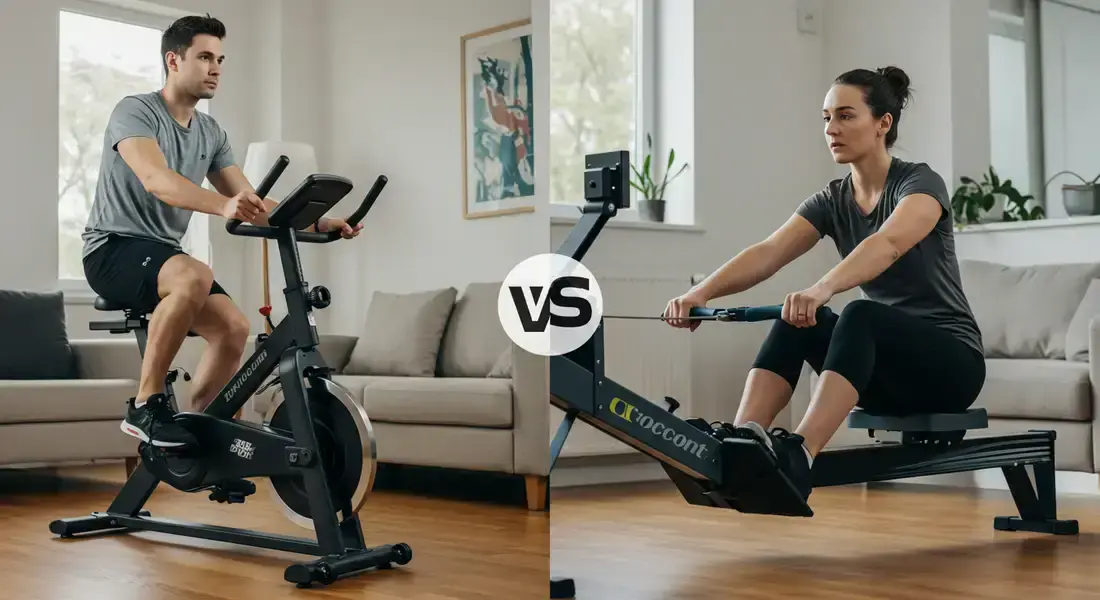
Both promise a fantastic workout and a path to better health, but they offer vastly different experiences, especially when you’re just starting out.
So, when it comes to the big exercise bike vs rower for beginners showdown, how do you confidently pick the machine that will not just fit your space, but truly fit you – your current fitness level, your specific goals, and your personal preferences?
This guide is your impartial referee, breaking down the pros, cons, and crucial differences to help you make an informed decision and select your perfect cardio partner.
Let the comparison commence!
The Quick Decision Matrix: Bike or Rower at a Glance
- Exercise Bike: Predominantly a lower-body workout, exceptionally gentle on joints, very easy to learn and use immediately. Often the go-to for: Absolute beginners, those with significant joint sensitivities, or if the main goal is building leg strength alongside steady cardio.
- Rowing Machine: Delivers a powerful full-body workout, boasts high calorie-burn potential, but has a steeper learning curve for proper form to maximize benefits and minimize injury risk. Often the go-to for: Individuals seeking total body engagement, a serious calorie challenge, and who are willing to invest time in mastering the technique.
- The Bottom Line: There’s no universally “wrong” choice, only the choice that’s right for you. Your body, your goals, and what you’ll genuinely enjoy (and therefore use consistently) are the ultimate deciders.
The Core Question – What Are Your Beginner Priorities? (A Quick Self-Assessment)
Before we dissect each machine, let’s turn the spotlight on you.
Your answers here will illuminate which machine’s strengths align best with your needs:
- Comfort & Ease of Getting Started: Is your absolute top priority a machine you can hop on and use effectively with minimal instruction almost immediately?
- Joint Impact Concerns: Do you have sensitive knees, hips, or a tricky back that demands the gentlest possible workout experience?
- Muscle Engagement Goals: Are you primarily looking for a cardiovascular workout with lower-body toning, or is a comprehensive, full-body challenge more appealing?
- Calorie Burn & Weight Management Focus: Is maximizing your calorie expenditure per workout session a key driver for your equipment choice?
- Space & Noise Considerations: How much room do you realistically have for the machine (both in use and for storage), and is a whisper-quiet operation essential for your home environment?
Take a moment to jot down your top 2-3 priorities from this list. Keep them in mind as we explore how each machine stacks up.
Meet the Contenders – A Snapshot of Each Machine for the Uninitiated
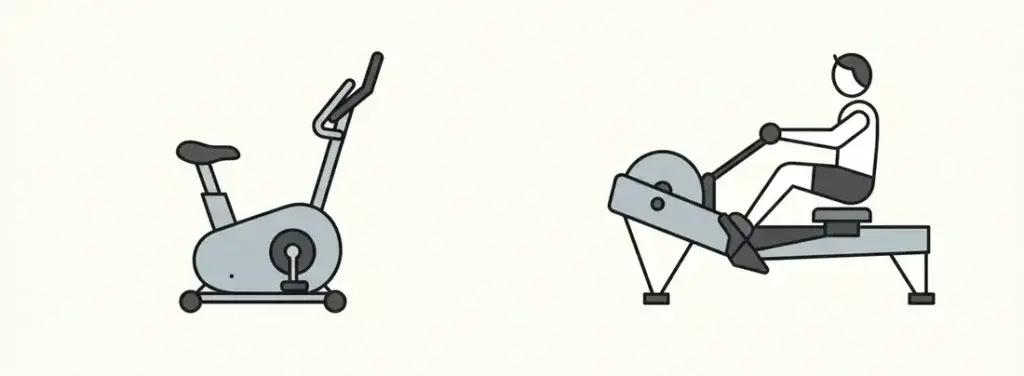
Rowing machines engage muscles throughout the entire body.
Let’s quickly introduce our two cardio champions:
A. The Exercise Bike – Your Trusty Steed
You’re likely familiar with this one. For this comparison, we’re mainly considering Upright and Recumbent exercise bikes, as they are most often pitted against rowers by beginners.
- Primary Action: Pedaling, engaging the lower body in a cyclical motion.
- Feel: Uprights mimic traditional cycling, while recumbents offer a laid-back, chair-like experience.
B. The Rowing Machine (Ergometer/Erg) – Your Full-Body Powerhouse
Often simply called an “erg,” a rowing machine simulates the action of rowing a boat.
- Primary Action: A coordinated sequence involving a powerful leg push, core engagement, and an upper body pull, all while sliding on a seat along a rail.
- Feel: A rhythmic, flowing motion that can feel incredibly powerful once mastered.
The Head-to-Head Showdown – Exercise Bike vs. Rower for Beginners
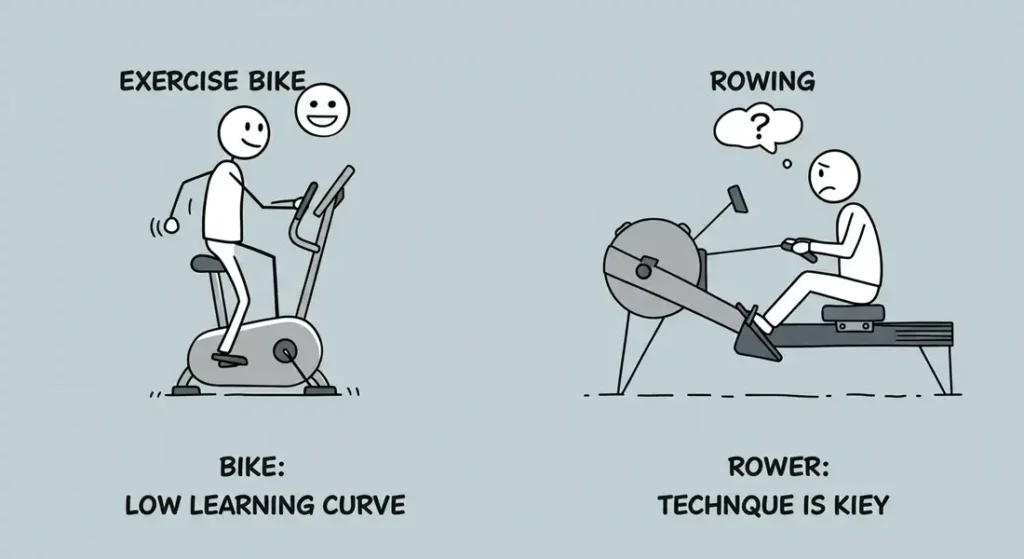
Now, let’s put these machines side-by-side across key factors crucial for beginners.
A. Learning Curve & Ease of Use – Hopping On vs. Mastering the Stroke
- Exercise Bike:
- Pros: The learning curve is practically flat. Most people can sit on an exercise bike and start pedaling effectively within minutes. Recumbent bikes are even easier, often feeling like sitting in a comfortable chair.
- Cons: While easy to use, proper exercise bike setup (seat height, etc.) is still important for comfort and efficiency, but it’s generally straightforward.
- Rowing Machine:
- Pros: Once you learn the correct technique, the rowing stroke is a smooth, rhythmic, and satisfying movement.
- Cons: This is the rower’s biggest hurdle for beginners. Proper rowing form is crucial and has a significantly steeper learning curve. Incorrect form (like yanking with the arms, hunching the back, or improper leg drive sequence) not only reduces the workout’s effectiveness but also significantly increases the risk of injury, especially to the lower back. Most beginners will need to watch tutorial videos (like those from Concept2, a leading rower manufacturer) or even seek some initial coaching.
- Beginner Verdict: Exercise bike wins hands-down for immediate ease of use and a minimal learning curve.
B. Joint Impact – Gentle Glides vs. Powerful Pulls
Both are generally considered “low-impact,” meaning they don’t involve jarring forces on your joints like running does.
However, there are nuances.
- Exercise Bike:
- Pros: Truly exceptionally low impact, especially recumbent models. The circular pedaling motion is very smooth and controlled, making it an excellent choice for individuals with arthritis, recovering from certain injuries, or with general joint sensitivities.
- Cons: Minimal, provided the bike is set up correctly to avoid undue stress on the knees.
- Rowing Machine:
- Pros: Also classified as low impact because your feet remain connected to the footplates, and there’s no pounding.
- Cons: While low impact, the movement is more dynamic and involves a wider range of motion through the knees, hips, and shoulders. Crucially, poor form can negate some of the low-impact benefits. For example, over-compressing your knees at the “catch” (the start of the stroke) or using your back incorrectly during the “drive” can place stress on these areas.
- Beginner Verdict: For the absolute gentlest experience, especially for those with pre-existing joint concerns or who are very deconditioned, the exercise bike (particularly a recumbent model) is generally more forgiving and inherently lower stress.
C. Muscle Engagement – Lower Body Blast vs. Total Body Symphony
This is where the two machines diverge significantly.
- Exercise Bike:
- Primary Muscles Worked: Quadriceps (front of thighs), hamstrings (back of thighs), glutes (buttocks), and calves. Your core muscles (abdominals and lower back) are also engaged for stability, especially on an upright bike.
- Secondary Muscles Worked: Very minimal upper body involvement.
- Rowing Machine:
- Primary Muscles Worked: Prepare for an impressive list! Reputable sources like the American Council on Exercise (ACE) suggest rowing engages about 86% of your body’s muscles. This includes:
- Legs: Quadriceps, glutes, hamstrings, and calves provide the power for the “drive” phase.
- Core: Abdominals, obliques, and lower back muscles are crucial for stabilizing your torso and transferring power from your legs to the handle.
- Upper Back: Latissimus dorsi (“lats”), trapezius, and rhomboids are heavily involved in the “pull” phase.
- Arms & Shoulders: Biceps, forearms, deltoids (shoulders) contribute to finishing the stroke.
- Primary Muscles Worked: Prepare for an impressive list! Reputable sources like the American Council on Exercise (ACE) suggest rowing engages about 86% of your body’s muscles. This includes:
- Beginner Verdict: If a full-body workout is your priority, the rowing machine is the clear winner, offering unparalleled muscle engagement from a single cardio machine. The exercise bike excels at targeted lower-body work.
D. Calorie Burn Potential – Steady Burn vs. Calorie Inferno
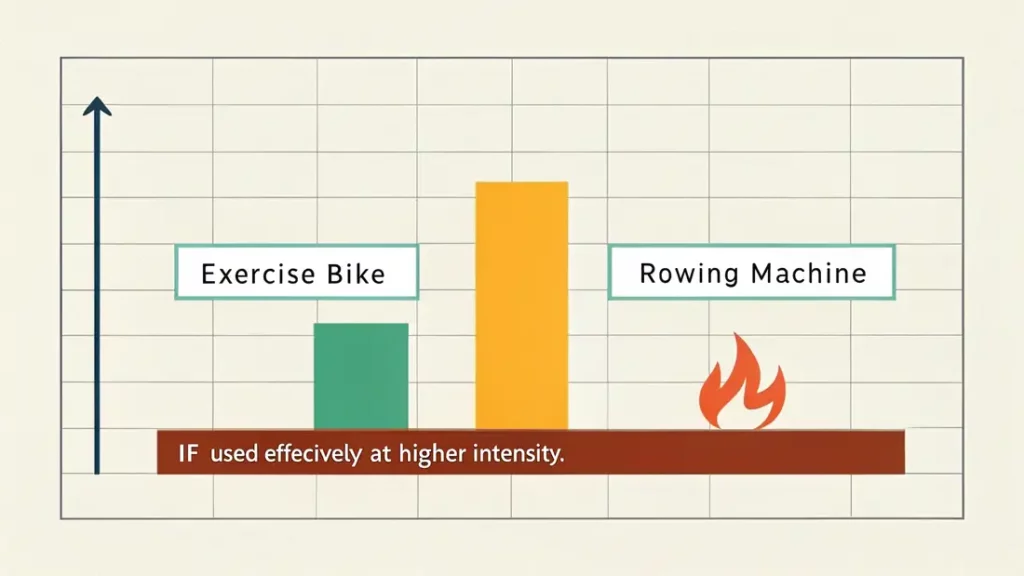
Because it uses so many muscle groups, the rowing machine generally has a higher potential for calorie expenditure per unit of time compared to an exercise bike, assuming similar perceived exertion levels.
More muscles working means more energy demanded.
- Exercise Bike: Provides a good, consistent calorie burn. The exact amount depends on your intensity, duration, and body weight.
- Rowing Machine: Has the potential to be a calorie-torching powerhouse. However, for beginners, there’s a caveat: you might not be able to sustain the high intensity needed for maximum calorie burn for very long until your form is solid and your overall fitness improves.
- Beginner Verdict: The rowing machine has a higher potential for calorie burn. However, an exercise bike might offer a more achievable and consistent calorie burn for a true beginner who can comfortably sustain a moderate workout for a longer duration from day one.
E. Workout Variety & Engagement Factor
This is subjective, but worth considering:
- Exercise Bike: Often easier to multitask – you can comfortably watch TV, read a book (especially on a recumbent), or listen to music/podcasts. Many bikes come with pre-set workout programs. If you opt for a spin bike, the world of online interactive classes opens up.
- Rowing Machine: Generally requires more mental focus, especially as a beginner learning form. However, many find the rhythmic nature of the stroke to be meditative. Modern rowers often have performance monitors (PMs) that provide a wealth of data (split times, power output, distance), which can be highly engaging and motivating for data-driven individuals.
- Beginner Verdict: It’s a tie, depending on your personality. If you prefer passive entertainment while working out, the exercise bike might be more appealing. If you enjoy focusing on technique and data, the rower could be more engaging once you’re past the initial learning phase.
F. Space & Storage – Compact Corner vs. Longer Footprint
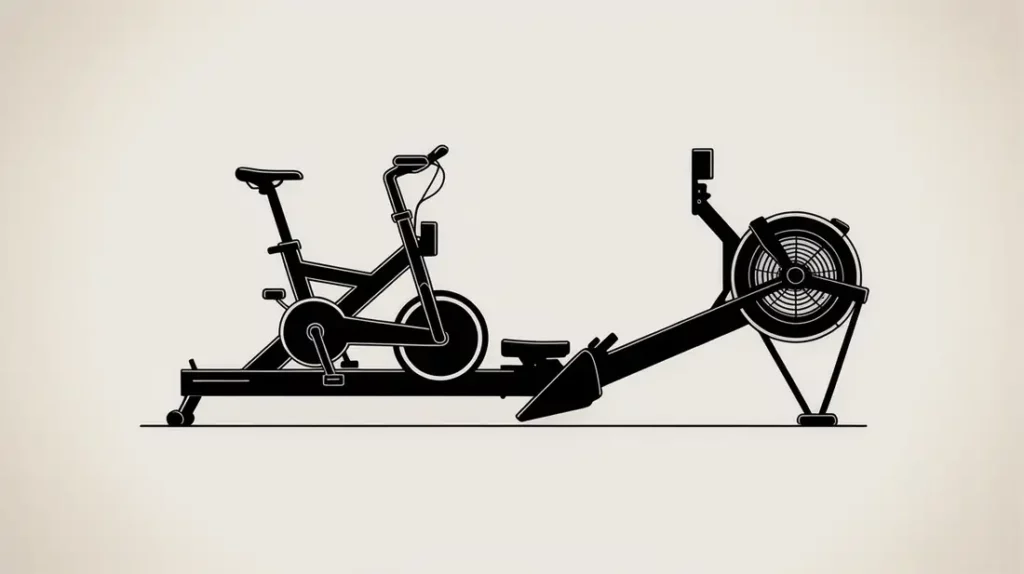
- Exercise Bike: Upright bikes are typically quite compact. Recumbent bikes have a longer footprint. Neither usually folds for storage (though a few exceptions exist).
- Rowing Machine: Rowers are generally longer than exercise bikes when in use, requiring a clear space of about 8-9 feet in length. However, a significant advantage is that many quality rowing machines are designed to be easily tilted up and stored vertically, taking up a surprisingly small footprint (often around 2×3 feet).
- Beginner Verdict: For in-use space, an upright exercise bike is often more compact. For storage space, a foldable/vertical storage rowing machine can be surprisingly efficient. Measure your space carefully!
G. Noise Levels – Whisper Quiet vs. Whooshing Air
- Exercise Bike:
- Magnetic Resistance Bikes: These are virtually silent, making them ideal for apartments or working out while others are sleeping.
- Friction Resistance Bikes (common on some spin bikes): Can produce a soft whirring or rubbing sound.
- Rowing Machine:
- Air Rowers (like many Concept2 models found in gyms): These are the loudest. The spinning flywheel fan creates a distinct “whooshing” sound that increases with effort. Some find it motivating; others find it disruptive.
- Magnetic Rowers: Significantly quieter, similar to magnetic exercise bikes.
- Water Rowers: Produce a gentle, rhythmic “sloshing” sound of water in a tank, which many users find soothing and pleasant.
- Beginner Verdict: For the quietest operation, a magnetic exercise bike or a magnetic/water rowing machine are your best bets. Air rowers are the loudest.
Quick Comparison Table: Bike vs. Rower at a Glance for Beginners
| Feature | Exercise Bike (Upright/Recumbent) | Rowing Machine | Winner for Most Beginners (Generalizing) |
| Ease of Use | ⭐⭐⭐⭐⭐ (Very Easy) | ⭐⭐ (Steeper Learning Curve) | Exercise Bike |
| Joint Impact | ⭐⭐⭐⭐⭐ (Extremely Low) | ⭐⭐⭐⭐ (Low, but form is key) | Exercise Bike (esp. Recumbent) |
| Muscle Engagement | Lower Body Focus | ⭐⭐⭐⭐⭐ (Full Body) | Rowing Machine |
| Calorie Burn Potential | Good | ⭐⭐⭐⭐ (Higher Potential) | Rowing Machine (if used effectively) |
| Form Forgiveness | ⭐⭐⭐⭐ (More Forgiving) | ⭐⭐ (Less Forgiving; technique vital) | Exercise Bike |
| Space (In Use) | Varies (Upright often smaller) | Generally Longer | Exercise Bike (Upright) |
| Space (Storage) | Usually Fixed Footprint | Many Fold/Store Vertically | Rowing Machine (if foldable) |
| Noise Level | Magnetic: Very Quiet | Air: Loud; Magnetic/Water: Quieter | Magnetic Exercise Bike/Rower |
(Star ratings are subjective for beginner-friendliness)
“Who Should Choose What?” Scenario-Based Recommendations for Beginners
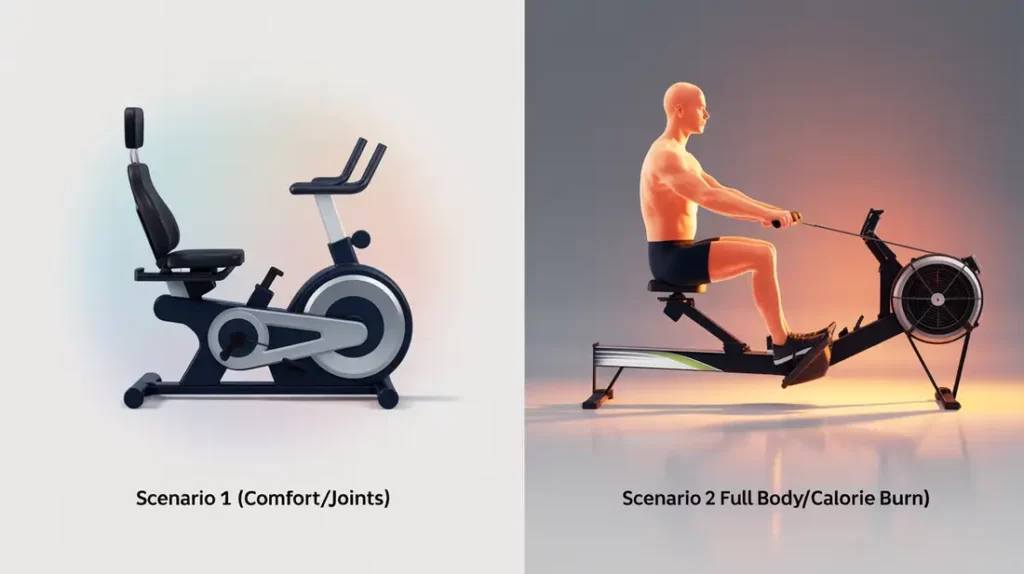
Let’s translate this into some common beginner scenarios:
- Scenario 1: “I’m brand new to exercise, perhaps carrying extra weight, have sensitive knees, and my absolute top priority is comfort and ease of starting.”
- Recommendation: Recumbent Exercise Bike. It offers maximum comfort, minimal joint stress, and is incredibly easy to hop on and use from day one.
- Scenario 2: “I want the biggest bang for my buck in terms of calorie burn and a full-body workout. I’m patient and willing to spend time learning proper technique.”
- Recommendation: Rowing Machine. Be prepared to watch tutorial videos and focus diligently on form. If noise is a concern in your home, lean towards a magnetic or water rower.
- Scenario 3: “I’m looking for a good cardiovascular workout, some toning for my legs, and something I can use fairly passively while watching TV or listening to a podcast without too much mental gymnastics.”
- Recommendation: Upright Exercise Bike. It’s familiar, effective for its purpose, and generally allows for easier multitasking.
- Scenario 4: “I live in a small apartment and space is a major constraint, both for use and storage.”
- Recommendation: This is a tough one. A compact Upright Exercise Bike might fit better for in-use space. However, if storage is the ultimate priority, a Rowing Machine that stores vertically can be surprisingly space-efficient when not in use. Measure your available area very carefully!
- Scenario 5: “I get bored easily and want a workout that feels more ‘athletic,’ dynamic, or mentally engaging once I get the hang of it.”
- Recommendation: The Rowing Machine often wins here. Mastering the technique, focusing on rhythm, and tracking performance data can be very engaging. Alternatively, if you like the idea of cycling but want more intensity and class-style motivation, a Spin Bike (a type of exercise bike) could be an option, though it also has a steeper curve for some beginners than standard uprights/recumbents.
The “Try Before You Buy” (If Possible) & Other Considerations
If you’re still on the fence, the best advice is to try both machines if possible.
- Visit a local gym (many offer day passes) or a fitness equipment store. Spend at least 10-15 minutes on each machine to get a feel for the movement and how your body responds.
- Read user reviews for specific models within your budget, paying attention to comments from other beginners.
- Think about your long-term fitness goals. Will your preferences change as you become fitter? Both machines can scale in intensity to challenge you for years to come.
Frequently Asked Questions (FAQs) – Bike vs. Rower for Newbies
- Q1: Which is definitively better for weight loss: an exercise bike or a rowing machine?
- A: Neither is “definitively” better because sustainable weight loss comes from consistently maintaining a calorie deficit. Both machines can help you burn significant calories. While a rower has the potential to burn more calories per hour due to greater muscle engagement, the “better” machine is the one you will use regularly, enjoyably, and with enough intensity to contribute to that deficit.
- Q2: I have a history of lower back pain. Can I safely use a rowing machine?
- A: This requires caution. While rowing with perfect form can actually help strengthen core and back muscles, incorrect rowing form is a very common cause of lower back strain or aggravation of existing issues. An exercise bike, particularly a recumbent model with good back support, is generally a safer initial choice for individuals with a history of back pain, unless specifically cleared and guided by a doctor or physical therapist for rowing.
- Q3: Is it harder to stay motivated on one type of machine versus the other?
- A: This is highly personal and depends on your personality! Some people find the rhythmic, flowing motion of rowing almost meditative and engaging. Others prefer the simplicity of an exercise bike, which allows them to easily zone out with music or TV. Consider what typically keeps you engaged in an activity.
- Q4: If a rower works so many more muscles, will I still get a “good enough” workout on an exercise bike?
- A: Absolutely! “Good enough” is relative to your goals. An exercise bike provides an excellent cardiovascular workout, strengthens your lower body, and can definitely help you achieve significant fitness improvements. It’s a fantastic and effective piece of equipment. Don’t feel you’re missing out if a bike is the right fit for you.
Conclusion – Your Best First Cardio Machine is a Personal Choice, Not a Universal Mandate
In the great exercise bike vs rower for beginners debate, there’s no single champion that suits everyone.
The “best” machine is the one that aligns with your individual needs, physical condition, fitness goals, available space, and, critically, what you genuinely think you’ll enjoy (or at least tolerate!) using consistently.
Use this guide as a framework. Reflect on your priorities. If possible, try both.
An exercise bike offers simplicity, comfort, and targeted lower-body work.
A rowing machine provides a powerful, full-body challenge with a higher learning curve. Both are capable of delivering fantastic results when used correctly and regularly.
The ultimate goal is to choose the cardio partner that will help you build a lasting, enjoyable fitness habit.
So, after considering all this, which machine is currently leading the race for you? Or do you have more questions? Share your thoughts and queries in the comments below – we’re here to help you make the best choice!
Ready to take the next step?
- Leaning towards an exercise bike? Dive deeper into the specifics with our Ultimate Beginner’s Guide to Choosing and Using an Exercise Bike at Home.
- Want to explore other equipment options for your home gym? Check out all our Beginner Fitness Guides.
Happy decision-making, and happy training!
